Republishing Warnings During Emergencies
Guidance on republishing warnings during emergencies for established emergency broadcasters, individuals and community members and private warning publishers or disseminators
Australian Disaster Resilience Handbook Collection, Guideline 2
14 pages, 2018
https://knowledge.aidr.org.au/media/5979/guideline-warnings-republishers.pdf
This guideline is a companion document to the Public
Information and Warnings Handbook (AIDR 2018).1 It
provides guidance on republishing warnings during
emergencies for established emergency broadcasters,
individuals and community members and private
warning publishers or disseminators. It outlines key
considerations for those who may be working with or
sharing content for warnings.
The provision of warnings enacts a national commitment
to building shared responsibility for disaster resilience, by
giving people information to make decisions about their
own safety.
In the context of warnings republishers, the
dissemination of warnings should be encouraged,
whether by formal or informal means, subject to a
range of key considerations. Republished warnings can
help expand the number and diversity of people that
receive official warnings and can assist individuals and
communities to take appropriate and timely actions that
save lives, livelihoods and property.
Warnings prompt and encourage protective action
to minimise the social and economic impacts of an
emergency. When republishing warnings, it is therefore,
important that:
• the accuracy and timeliness of republished warnings
is preserved
• appropriate contextual information – especially
relating to the reliability and source of warnings – is
properly communicated with republished warnings.
This guideline is intended to be advisory. It is not intended
to limit flexibility and individual jurisdictional practice or
to impose mandatory requirements. Rather, it should
be used to complement any existing Commonwealth,
state and territory guidelines for warnings republishers
and may be adopted into jurisdictional or organisational
codes of practice.
